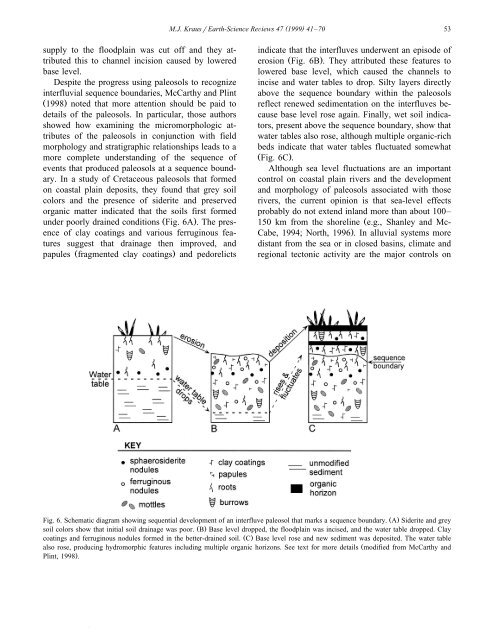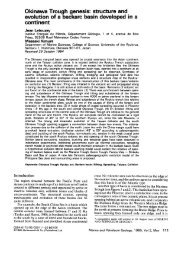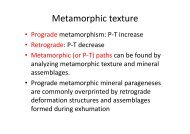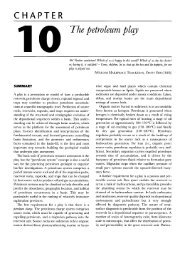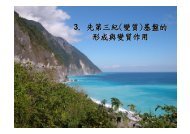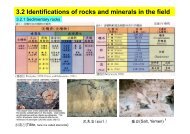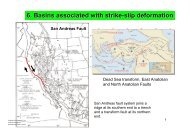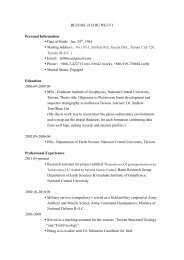Paleosols in clastic sedimentary rocks: their geologic applications
Paleosols in clastic sedimentary rocks: their geologic applications
Paleosols in clastic sedimentary rocks: their geologic applications
- No tags were found...
You also want an ePaper? Increase the reach of your titles
YUMPU automatically turns print PDFs into web optimized ePapers that Google loves.
( )M.J. KrausrEarth-Science ReÕiews 47 1999 41–70 53supply to the floodpla<strong>in</strong> was cut off and they attributedthis to channel <strong>in</strong>cision caused by loweredbase level.Despite the progress us<strong>in</strong>g paleosols to recognize<strong>in</strong>terfluvial sequence boundaries, McCarthy and Pl<strong>in</strong>tŽ 1998.noted that more attention should be paid todetails of the paleosols. In particular, those authorsshowed how exam<strong>in</strong><strong>in</strong>g the micromorphologic attributesof the paleosols <strong>in</strong> conjunction with fieldmorphology and stratigraphic relationships leads to amore complete understand<strong>in</strong>g of the sequence ofevents that produced paleosols at a sequence boundary.In a study of Cretaceous paleosols that formedon coastal pla<strong>in</strong> deposits, they found that grey soilcolors and the presence of siderite and preservedorganic matter <strong>in</strong>dicated that the soils first formedunder poorly dra<strong>in</strong>ed conditions Ž Fig. 6A .. The presenceof clay coat<strong>in</strong>gs and various ferrug<strong>in</strong>ous featuressuggest that dra<strong>in</strong>age then improved, andpapules Ž fragmented clay coat<strong>in</strong>gs.and pedorelicts<strong>in</strong>dicate that the <strong>in</strong>terfluves underwent an episode oferosion Ž Fig. 6B .. They attributed these features tolowered base level, which caused the channels to<strong>in</strong>cise and water tables to drop. Silty layers directlyabove the sequence boundary with<strong>in</strong> the paleosolsreflect renewed sedimentation on the <strong>in</strong>terfluves becausebase level rose aga<strong>in</strong>. F<strong>in</strong>ally, wet soil <strong>in</strong>dicators,present above the sequence boundary, show thatwater tables also rose, although multiple organic-richbeds <strong>in</strong>dicate that water tables fluctuated somewhatŽ Fig. 6C ..Although sea level fluctuations are an importantcontrol on coastal pla<strong>in</strong> rivers and the developmentand morphology of paleosols associated with thoserivers, the current op<strong>in</strong>ion is that sea-level effectsprobably do not extend <strong>in</strong>land more than about 100–150 km from the shorel<strong>in</strong>e Že.g., Shanley and Mc-Cabe, 1994; North, 1996 .. In alluvial systems moredistant from the sea or <strong>in</strong> closed bas<strong>in</strong>s, climate andregional tectonic activity are the major controls onFig. 6. Schematic diagram show<strong>in</strong>g sequential development of an <strong>in</strong>terfluve paleosol that marks a sequence boundary. Ž A.Siderite and greysoil colors show that <strong>in</strong>itial soil dra<strong>in</strong>age was poor. Ž B.Base level dropped, the floodpla<strong>in</strong> was <strong>in</strong>cised, and the water table dropped. Claycoat<strong>in</strong>gs and ferrug<strong>in</strong>ous nodules formed <strong>in</strong> the better-dra<strong>in</strong>ed soil. Ž C.Base level rose and new sediment was deposited. The water tablealso rose, produc<strong>in</strong>g hydromorphic features <strong>in</strong>clud<strong>in</strong>g multiple organic horizons. See text for more details Žmodified from McCarthy andPl<strong>in</strong>t, 1998 ..


